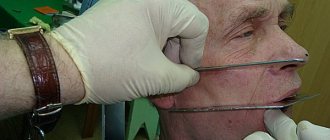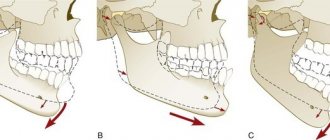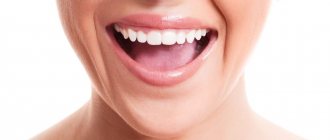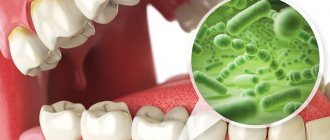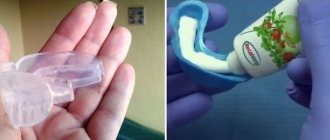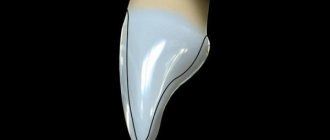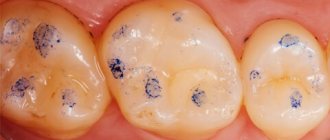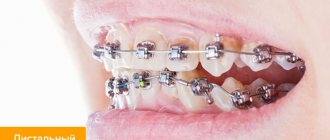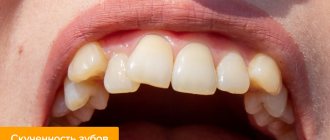Dr. Kizim
>
Articles
>
Occlusal plane of teeth in dentistry
To determine the position of teeth in the dentition, the concept of the occlusal plane is used. Its definition is extremely important, since it is this concept that best describes a person’s bite.
The occlusal plane of the teeth is an imaginary line that runs along the cutting edges of the frontal and occlusal surfaces of the chewing teeth. Starting from the plane of the upper dentition, you can determine its maximum closure with the lower one. Thus, dentists can judge the fissure-tubercle contact of the teeth and talk about their mutual fit.
Characteristics of the occlusal plane of teeth
The contours of the occlusal plane are not symmetrical. The upper arc is more convex, and the lower one is concave. The convexity of the upper arch is determined by the position of the upper teeth. In this row, the teeth seem to be curved towards the cheek. And the teeth of the lower row, on the contrary, are slightly tilted towards the tongue. This is how nature intended so that the dentition interacts with each other as productively as possible and chews food efficiently. During the chewing process, the complex trajectory of the bend of the lower jaw should ideally coincide as much as possible with the occlusal curve: this ensures the full and most correct use of the teeth during chewing.
Occlusal surface
The occlusal surface of natural teeth is the part of the tooth surface from the tops of the cusps to the deepest part of the central fissure. It is characterized by anatomical features that are genetically tailored for function. The occlusal surface has the following elements: the tops of the tubercles, their bases, slopes, ridges, triangular ridges of the slopes of the tubercles and the marginal fossae limiting the so-called occlusal table, central and additional fissures (Fig. 2.19). The internal slopes of the tubercles of the teeth face the central fissure.
The cusps of the teeth are the main element of the occlusal surface. Their location determines the shape of the tooth. Each tubercle has a base, apex and slopes. The top of the tubercle of each tooth is slightly shifted towards the middle of the chewing surface.
Rice. 2.19. Morphology of the occlusal surface of the upper premolar (a) and central incisor (b). a: 1 - apex of the palatine tubercle; 2 - triangular ridge of the internal slope of the tubercle; 3 - central fissure; 4 - marginal fossa; 5 - crest of the tubercle; 6 - apex of the buccal tubercle; 7 - marginal ridge along the periphery of the occlusal surface; 8 - external slope of the tubercle; 9 — base of the tubercle; b: 1 - cutting edge; 2 - dental tubercle; 3 - median roller; 4, 5 — mesial and distal marginal ridges; 6 - pits.
The apices of all tubercles are connected by a marginal ridge, which limits the occlusal surface along the periphery. The largest transverse diameter of the tooth is 2 times the diameter of the occlusal surface (Fig. 2.20). Triangular ridges run from the top of the tooth tubercle to the middle of its chewing surface. The opposing occlusal surfaces slide along these convex ridges—the ridges of the tubercle.
The slopes of the tubercles facing the central fissure are designated as internal, and those located orally and vestibularly as external. In the approximal areas, the tooth has mesial and distal marginal pits. The marginal pits of two adjacent teeth form a pit for the tubercle of the antagonist tooth.
The central fissure separates the buccal and lingual cusps of the teeth. The slopes and ridges of the main tubercles converge in the central and additional fissures.
The occlusal (palatal) surface of the upper incisors and canines on the mesial and distal sides has two marginal ridges, which are connected by a dental tubercle in the lower third of the tooth.
Rice. 2.20. Occlusal surfaces, cusp slopes, “occlusal table” of the upper right premolar. B - external, vestibular; D - distal; M - mesial; H - oral surface of the tooth; 2, 1 - mesial and distal slopes of the buccal tubercle; 4, 3 - mesial and distal slopes of the palatine tubercle; 5, 6, 7, 8 - internal slopes of the tubercles; 9, 10—marginal pits. Between the tops of the tubercles and the center of the tooth there are triangular ridges of the slopes of the tubercles. The internal slopes of tubercles 5, 6, 7, 8, limited by the marginal ridge, are the “occlusal table.”
Between the middle of the cutting edge and this tubercle there is a median palatal ridge, on both sides of which there are grooves. The dental cusp is the most convex part of the tooth and is the site of occlusal contacts.
The buccal tubercles of the lower and palatal upper chewing teeth are called abutment teeth, since they crush food, determine the nature of movements of the lower jaw within the occlusal field, and redistribute chewing forces so that the main chewing load is along the axis of the tooth.
The lingual cusps of the lower and buccal cusps of the upper chewing teeth are called non-supporting, “protective”. In central occlusion they have easy contact with antagonists or, according to some authors, do not have such contact. These tubercles carry out the function of separating food, create sliding surfaces on their slopes for antagonists, and when chewing, protect the tongue and cheeks from getting between the teeth.
Point (not planar) multiple, uniform contacts of antagonizing teeth are the most favorable form of occlusion for the chewing function, which should be created when modeling the occlusal surface (Fig. 2.21). In this case, it is possible to process food of any consistency, chewing pressure is distributed along the axis of the teeth, the load on the periodontium is minimal, small point contacts reduce abrasion of the chewing planes. The contact of the cusps and fissures according to the “pestle in mortar” principle creates stability of the lower jaw in the position of central occlusion and does not interfere with the movement of the lower jaw within the occlusal field.
Rice. 2.21. Point occlusal contacts of the cusps and fissures of the teeth of the upper and lower jaws. The circles are the supporting buccal cusps of the lower teeth and the corresponding contacts with the teeth of the upper jaw; black dots are the supporting palatal cusps of the upper teeth and corresponding contacts with the teeth of the lower jaw.
Rice. 2.22. Three options for the relationship between tubercles and fossae in the position of central occlusion. a - “free central occlusion”: the tops of the tubercles are in contact with the bottom of the pits, free spaces around the tubercles, axial loads on the periodontium are indicated by arrows; b - point contacts of the slopes of the tubercles: horizontal loads on the periodontium are possible, the tops of the tubercles are not subject to abrasion: 1, 2, 3 - classes of the occlusal surface; c - “lingualized occlusion” (used for prosthetics on implants). Rice. 2.23. Trajectories of the main movements of the lower jaw [according to R. Marxkors, 1993]. a - “occlusal compass” on the upper first molars; b - “occlusal compasses” on the teeth of the lower jaw - a mirror image of those on the teeth of the upper jaw. The black line is the path of forward movement; blue - the path of the labor movement; green - the path of balancing movement; red dots—central occlusion.
There are two ways to model occlusal contacts in the position of central occlusion (Fig. 2.22): three-point contacts of the slopes of the supporting tubercles and contact of the tops of the tubercles with fissures and marginal fossae. The second method is easier to implement; it eliminates the horizontal load that occurs between the internal slopes of the supporting tubercles, but its use increases the risk of excessive abrasion of the tops of the tubercles.
If we designate the path of movement of each supporting tubercle in the corresponding fossa or fissure of the opposing tooth from the central position to the anterior occlusion position, to the working and balancing sides, we will obtain the trajectory of the main movements of the lower jaw, the so-called occlusal compass (Fig. 2.23). On the teeth of the upper jaw, the path of anterior movement of the cusps of the lower teeth is directed forward, and on the teeth of the lower jaw - backward. The movement of the supporting tubercle to the working side is perpendicular to the path of the forward movement, and the movement of the supporting tubercle to the balancing side is directed at an angle of -45° to the path of the forward movement. Consequently, the cusps of each tooth should be so located that during lateral movements of the lower jaw they pass “in the span” between the cusps of opposing teeth and so that there are no occlusal obstacles on the working and balancing sides.
If the occlusal surface of the teeth is lost (absence of teeth), when restoring it, an occlusal plane is used, passing through 3 points: the contact of the lower central incisors (incisal point) and the tops of the distal buccal cusps of the second lower molars. This plane is parallel to the Camper horizontal and is used to install the model of the lower jaw into the articulator according to the average data (using, for example, a balancer) (Fig. 2.24).
Rice. 2.24. The occlusal plane between the incisal point and the distobuccal cusps of the second molars.
V.A.Khvatova Clinical gnathology
Source: https://medbe.ru
Diagnostic value
The occlusal plane in dentistry is of great diagnostic importance. Throughout life, the human maxillary and mandibular system undergoes significant changes. As a rule, before serious orthodontic problems arise, the occlusal plane has already changed its parameters. Filled teeth, worn tooth surfaces, compensation for lost teeth by their neighbors - all this changes the line of the occlusal plane.
Therefore, when reconstructing the dentition, it is important to know how to restore each tooth, how the jaws will interact, and whether the abrasion of the tooth surface will change with a change in the occlusal plane. Reconstruction of the lost lines, taking into account the remaining teeth and those that will need to be replaced, will create an optimal relationship between the upper and lower jaw. The restored occlusal plane helps solve this issue, after which the doctor can begin practical orthodontics.
One of the most important parameters in restorative dentistry, that is, the ideal placement of dentures in the dentition, depends on the correct determination of the occlusal plane. Since dental prosthetics is an expensive and responsible procedure, it is best to contact competent specialists. Only highly qualified dentists with sufficient experience can correctly determine the contours of the occlusal plane. This will become the starting point for the doctor’s further work. With the help of a clear definition of the occlusal plane, it is possible to recreate not only beautiful, straight teeth, but also to restore the former aesthetics of the smile, and preserve chewing and speech functions.
What else is remarkable about the Spee curve?
Also, according to Spee, a researcher and practitioner, the occlusal curve is completely connected with the articular path, since it, together with the curve of the row of teeth, is formed by one radius, and accordingly, the teeth and the articular head slide along one circle forward and the steeper the inclination of the articular path, the more uniform the occlusal curve is concave. Such assumptions made by the scientist met with many objections. Other scientists argue that the occlusal curve cannot be called a segment of a circle. In its continuation, the sagittal curve of Spee often passes below or above the articular path, and its center is not in the orbit.
Subtleties of determining central occlusion and possible errors
All movements of the lower jaw are regulated by the neuromuscular system. The temporomandibular joint ensures a fixed position of the jaws and when there is a balance between the jaws, the temporomandibular joint and the muscles of mastication, optimal functioning of the neuromuscular system occurs.
If one component of the chewing system does not function correctly, this affects the condition of the remaining structures.
A striking example of such a disorder is the uneven distribution of chewing pressure after dental restoration, orthopedic intervention or orthodontic treatment.
In such cases, excessive stress occurs on individual teeth and occlusal disharmony occurs. It should be noted that occlusion can occur for various reasons (local and general causes).
Occlusal pads.
Most often, occlusal overlays are placed on the supporting surfaces of the tooth crowns and placed in places that do not interfere with the occlusal movements of the lower jaw.
For this purpose, supporting teeth, standing nearby or far away, are used. In some cases, special recesses are created on the supporting surfaces of the crowns of natural teeth and occlusal overlays are placed there.
It is known that the occlusal pad is a structural part of the clasp, but it can also be an independent functioning link in the design of the clasp prosthesis. Thanks to the occlusal overlay, such problems as settlement of the prosthesis under load, distribution of the chewing load, unloading the abutment tooth, creating contact between the prosthesis and the abutment tooth (prevents food from entering), restoration of impaired occlusal contact with the antagonist, and restoration of the height of worn crowns are solved.
It should be noted that the distribution of the load on the abutment tooth through the occlusal pads is carried out in different ways. Here, a significant role is played by such factors as the size and shape of the occlusal pads, location, and the shape of the bed for the occlusal pads. When occlusal pads cover the entire supporting surface of the tooth, the load on the pad is transmitted along the long axis of the tooth, distributing it evenly.
A similar effect is achieved by two occlusal pads located opposite each other. If the onlay is located on one side (on the aproxal side of the tooth, on the side of the dentition defect), the periodontal load changes.
Occlusal plane.
The occlusal plane is the surface passing through the cutting edges of the first incisors of the lower jaw and the distal buccal cusps of the wisdom teeth.
It is important to understand that the position of the occlusal plane has great functional and diagnostic significance. The bone relationship of the jaws changes all the time and to achieve optimal function, compensation is carried out by developed dentoalveolar ridges. The orthopedic occlusal plane is the surface between the incisal edge of the lower incisors and the distal cusps of the first lower molars.
It is important to understand that during treatment it is necessary to restore each tooth, recreate the cusps and fissures of the teeth, this guarantees the absence of further problems associated with disruption of the occlusal interactions of the jaws, pathological abrasion and a decrease in occlusal height.
Today, there are quite a few methods for restoring the anatomical shape of teeth; for this I use silicone splints. Since, under pathological conditions, the masticatory apparatus does not function fully, occlusal splints are used in the treatment of complex pathologies, such as TMJ dysfunction, dental anomalies, increased abrasion of hard dental tissues, periodontal disease, etc.
| Consequences of TMJ dysfunction | ||||
| The movement of the lower jaw is provided by the TMJ. This is a complex activity of the body, which is presented in the form of chewing, swallowing, talking, yawning. The harmonious functioning of the masticatory muscles (providing precise movement of the joint) is carried out only if there is no dysfunction (TMJ dysfunction) | ||||
| Neurological clinic | ||||
| headache | dizziness | clicking and crunching of the joint | muscle tension | spasms in the head, neck, throat |
| Otological clinic | ||||
| noise in ears | ringing | stuffy ears | hearing loss | |
| Hidden and long-term consequences of TMJ dysfunction | ||||
| Cervical lordosis | Curvature in the sacroiliac joint (pelvic bones) |
